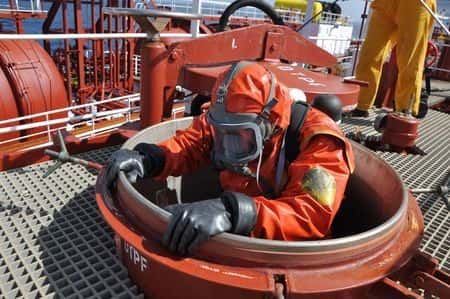Worker Suffers Respiratory Illness from Exposure to Ammonia Cleaner
Updated on
Plaintiff was exposed to ammonia while cleaning the wheelhouse of a ship located in Washington. He spent 30 minutes in the wheelhouse for his cleaning duties that day. All windows and doors were closed. Plaintiff was not aware of any hazards in using ammonia. After finishing his shift, he went to bed. He awoke feeling faint and having trouble breathing. He spent six days in the hospital on a breathing bypass mask with air supply and medicine for his respiratory problems. Upon discharge from the hospital, he had two prescriptions for his breathing difficulties, one for daily treatment purposes, and the other for emergency use.
Question(s) For Expert Witness
What is the estimated level of exposure?
Expert Witness Response
 The concentration to which the plaintiff was exposed was likely in the vicinity of 433 ppm. Part of the basis for this analysis was derived from depositions of plaintiff and his coworker. The cleaner used to clean the walls, windows and ceiling had had household ammonia added to it in a ratio of approximately 1 part ammonia to 12 parts water. Although Material Safety Data Sheet (MSDS) that was supplied does not specify the percentage of ammonia (NH3) that is in the household ammonia, the percentage is commonly has high as 10% by weight; 10% by weight is assumed in this analysis. Since the household ammonia was diluted by an estimated additional 12 parts water to 1 part ammonia, the solution would have been 1/12th of 0.1, or 0.00833.
The concentration to which the plaintiff was exposed was likely in the vicinity of 433 ppm. Part of the basis for this analysis was derived from depositions of plaintiff and his coworker. The cleaner used to clean the walls, windows and ceiling had had household ammonia added to it in a ratio of approximately 1 part ammonia to 12 parts water. Although Material Safety Data Sheet (MSDS) that was supplied does not specify the percentage of ammonia (NH3) that is in the household ammonia, the percentage is commonly has high as 10% by weight; 10% by weight is assumed in this analysis. Since the household ammonia was diluted by an estimated additional 12 parts water to 1 part ammonia, the solution would have been 1/12th of 0.1, or 0.00833.
 The dimensions of the wheelhouse were estimated 10 ft by 10 ft. Since plaintiff noted that he could reach the ceiling to clean it, I am using a ceiling height of 7 ft instead of 8 ft. Based on this, the volume of the wheelhouse was about 10 ft x 10 ft x 7 ft = 700 ft3 (19.8 m3), and the surface area to be cleaned would be 100 ft2 each for the ceiling (the floor was mopped with only soap and water without ammonia), and 70 ft2 for each of the four sides, for a total of 380 ft2 (35.3 m2).
The dimensions of the wheelhouse were estimated 10 ft by 10 ft. Since plaintiff noted that he could reach the ceiling to clean it, I am using a ceiling height of 7 ft instead of 8 ft. Based on this, the volume of the wheelhouse was about 10 ft x 10 ft x 7 ft = 700 ft3 (19.8 m3), and the surface area to be cleaned would be 100 ft2 each for the ceiling (the floor was mopped with only soap and water without ammonia), and 70 ft2 for each of the four sides, for a total of 380 ft2 (35.3 m2).
 Without ventilation, no ammonia would be removed from the air. The ammonia added to the air would be from evaporation of the ammonia used in cleaning the wheelhouse. Since the ammonia evaporates very rapidly (EIIP, 2007) -- much faster than water -- and becomes well mixed with the air in the room in a matter of minutes (L.E. Sparks, 2002), the concentration throughout the room will be very nearly equal to the amount of the ammonia used in the cleaning divided by the volume of the room.
Without ventilation, no ammonia would be removed from the air. The ammonia added to the air would be from evaporation of the ammonia used in cleaning the wheelhouse. Since the ammonia evaporates very rapidly (EIIP, 2007) -- much faster than water -- and becomes well mixed with the air in the room in a matter of minutes (L.E. Sparks, 2002), the concentration throughout the room will be very nearly equal to the amount of the ammonia used in the cleaning divided by the volume of the room.
 The amount of ammonia used in the cleaning is the amount of cleaner used times the proportion of ammonia in the cleaner. While there is little information available regarding the amount of cleaner needed to cover a specified area of surface, information was found for one commercial product, one ounce (28.35g) will cover 15 ft2 (1.39 m2), which would be 20.4 g/m2. The total ammonia emitted into the air within the wheelhouse would then be 20.4 grams of water/m2 x 35.3 m2 x 0.00833 grams of ammonia/gram of water = 6.00 g. Dividing by the volume to get a concentration gives 6.00 g / 19.8 m3 = 0.303 g/m3 = 303 mg/m3 = 433 ppm.
The amount of ammonia used in the cleaning is the amount of cleaner used times the proportion of ammonia in the cleaner. While there is little information available regarding the amount of cleaner needed to cover a specified area of surface, information was found for one commercial product, one ounce (28.35g) will cover 15 ft2 (1.39 m2), which would be 20.4 g/m2. The total ammonia emitted into the air within the wheelhouse would then be 20.4 grams of water/m2 x 35.3 m2 x 0.00833 grams of ammonia/gram of water = 6.00 g. Dividing by the volume to get a concentration gives 6.00 g / 19.8 m3 = 0.303 g/m3 = 303 mg/m3 = 433 ppm.
 Note that if the ammonia were not yet well mixed through the room, the highest concentrations would occur where plaintiff was working, which would have resulted in exposure to higher concentrations than are predicted in this report. Note, also, that plaintiff reported a strong odor when he wrung out the cleaning rag, which indicates that, each time he wrung out the rag, he was exposed to higher concentrations than would be the case if the ammonia were well mixed with the air.
Note that if the ammonia were not yet well mixed through the room, the highest concentrations would occur where plaintiff was working, which would have resulted in exposure to higher concentrations than are predicted in this report. Note, also, that plaintiff reported a strong odor when he wrung out the cleaning rag, which indicates that, each time he wrung out the rag, he was exposed to higher concentrations than would be the case if the ammonia were well mixed with the air.
Subscribe to our newsletter
Join our newsletter to stay up to date on legal news, insights and product updates from Expert Institute.
Sign up nowFind an expert witness near you
What State is your case in?
Subscribe to our newsletter
Join our newsletter to stay up to date on legal news, insights and product updates from Expert Institute.


